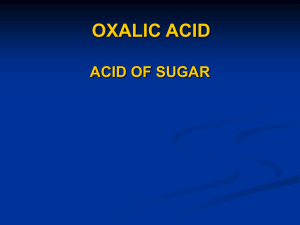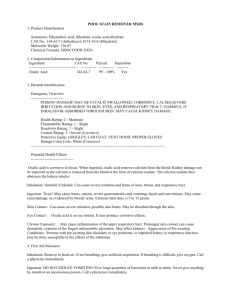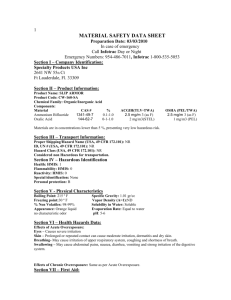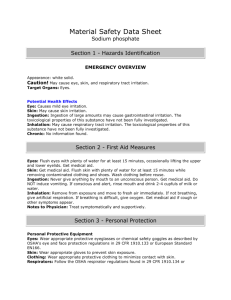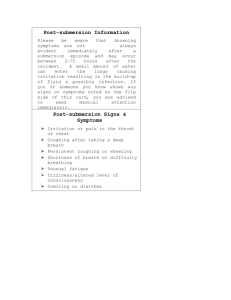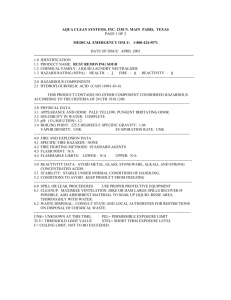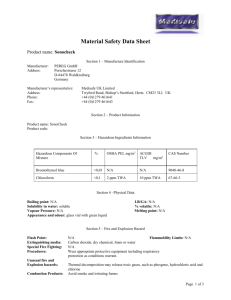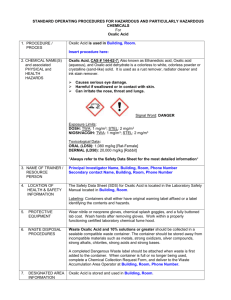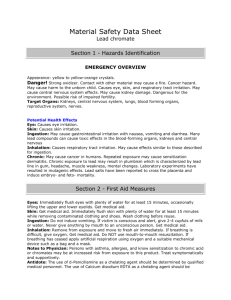Oxalic Acid, 5% w/v
advertisement
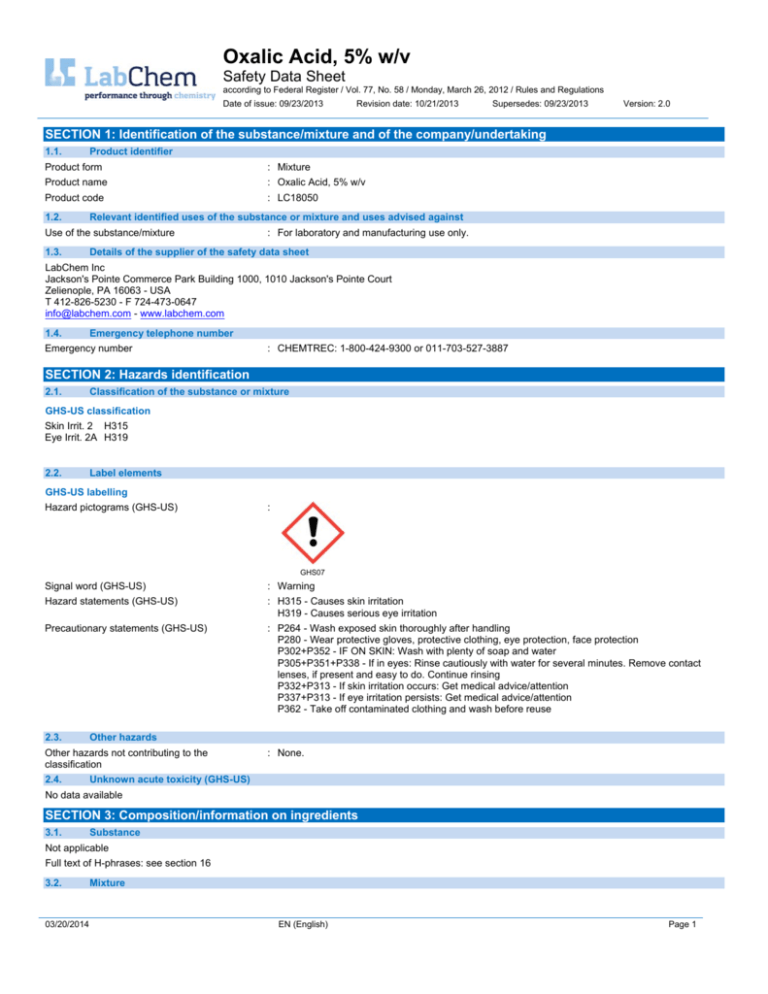
Oxalic Acid, 5% w/v Safety Data Sheet according to Federal Register / Vol. 77, No. 58 / Monday, March 26, 2012 / Rules and Regulations Date of issue: 09/23/2013 Revision date: 10/21/2013 Supersedes: 09/23/2013 Version: 2.0 SECTION 1: Identification of the substance/mixture and of the company/undertaking 1.1. Product identifier Product form : Mixture Product name : Oxalic Acid, 5% w/v Product code : LC18050 1.2. Relevant identified uses of the substance or mixture and uses advised against Use of the substance/mixture 1.3. : For laboratory and manufacturing use only. Details of the supplier of the safety data sheet LabChem Inc Jackson's Pointe Commerce Park Building 1000, 1010 Jackson's Pointe Court Zelienople, PA 16063 - USA T 412-826-5230 - F 724-473-0647 info@labchem.com - www.labchem.com 1.4. Emergency telephone number Emergency number : CHEMTREC: 1-800-424-9300 or 011-703-527-3887 SECTION 2: Hazards identification 2.1. Classification of the substance or mixture GHS-US classification Skin Irrit. 2 H315 Eye Irrit. 2A H319 2.2. Label elements GHS-US labelling Hazard pictograms (GHS-US) : Signal word (GHS-US) : Warning Hazard statements (GHS-US) : H315 - Causes skin irritation H319 - Causes serious eye irritation Precautionary statements (GHS-US) : P264 - Wash exposed skin thoroughly after handling P280 - Wear protective gloves, protective clothing, eye protection, face protection P302+P352 - IF ON SKIN: Wash with plenty of soap and water P305+P351+P338 - If in eyes: Rinse cautiously with water for several minutes. Remove contact lenses, if present and easy to do. Continue rinsing P332+P313 - If skin irritation occurs: Get medical advice/attention P337+P313 - If eye irritation persists: Get medical advice/attention P362 - Take off contaminated clothing and wash before reuse GHS07 2.3. Other hazards Other hazards not contributing to the classification 2.4. : None. Unknown acute toxicity (GHS-US) No data available SECTION 3: Composition/information on ingredients 3.1. Substance Not applicable Full text of H-phrases: see section 16 3.2. 03/20/2014 Mixture EN (English) Page 1 Oxalic Acid, 5% w/v Safety Data Sheet according to Federal Register / Vol. 77, No. 58 / Monday, March 26, 2012 / Rules and Regulations Name Product identifier % Water (CAS No) 7732-18-5 95 GHS-US classification Not classified Oxalic Acid, Dihydrate (CAS No) 6153-56-6 5 Skin Corr. 1B, H314 Eye Dam. 1, H318 SECTION 4: First aid measures 4.1. Description of first aid measures First-aid measures general : Never give anything by mouth to an unconscious person. If you feel unwell, seek medical advice (show the label where possible). First-aid measures after inhalation : Assure fresh air breathing. Allow the victim to rest. First-aid measures after skin contact : Wash with plenty of soap and water. Wash contaminated clothing before reuse. If skin irritation occurs: Get medical advice/attention. First-aid measures after eye contact : Rinse cautiously with water for several minutes. Remove contact lenses, if present and easy to do. Continue rinsing. If eye irritation persists: Get medical advice/attention. First-aid measures after ingestion : Rinse mouth. Do NOT induce vomiting. Obtain emergency medical attention. 4.2. Most important symptoms and effects, both acute and delayed Symptoms/injuries after skin contact : Causes skin irritation. Symptoms/injuries after eye contact : Causes serious eye irritation. Chronic symptoms : Kidney disorders. 4.3. Indication of any immediate medical attention and special treatment needed Obtain medical assistance. SECTION 5: Firefighting measures 5.1. Extinguishing media Suitable extinguishing media : Foam. Dry powder. Carbon dioxide. Water spray. Sand. Unsuitable extinguishing media : Do not use a heavy water stream. 5.2. Special hazards arising from the substance or mixture No additional information available 5.3. Advice for firefighters Firefighting instructions : Use water spray or fog for cooling exposed containers. Exercise caution when fighting any chemical fire. Prevent fire-fighting water from entering environment. Protection during firefighting : Do not enter fire area without proper protective equipment, including respiratory protection. SECTION 6: Accidental release measures 6.1. Personal precautions, protective equipment and emergency procedures 6.1.1. For non-emergency personnel Protective equipment : Safety glasses. Gloves. Emergency procedures : Evacuate unnecessary personnel. 6.1.2. For emergency responders Protective equipment : Equip cleanup crew with proper protection. Emergency procedures : Ventilate area. 6.2. Environmental precautions Prevent entry to sewers and public waters. Notify authorities if liquid enters sewers or public waters. 6.3. Methods and material for containment and cleaning up Methods for cleaning up 6.4. : Soak up spills with inert solids, such as clay or diatomaceous earth as soon as possible. Collect spillage. Store away from other materials. Reference to other sections See Heading 8. Exposure controls and personal protection. SECTION 7: Handling and storage 7.1. Precautions for safe handling Precautions for safe handling : Wash hands and other exposed areas with mild soap and water before eating, drinking or smoking and when leaving work. Provide good ventilation in process area to prevent formation of vapour. Hygiene measures : Wash exposed skin thoroughly after handling. 03/20/2014 EN (English) 2/7 Oxalic Acid, 5% w/v Safety Data Sheet according to Federal Register / Vol. 77, No. 58 / Monday, March 26, 2012 / Rules and Regulations 7.2. Conditions for safe storage, including any incompatibilities Storage conditions : Keep only in the original container in a cool, well ventilated place away from : incompatible materials. Keep container closed when not in use. Incompatible products : Strong oxidizers. silver nitrate. Mercury (Hg). Sodium hypochlorite. Strong bases. Incompatible materials : Sources of ignition. Direct sunlight. 7.3. Specific end use(s) No additional information available SECTION 8: Exposure controls/personal protection 8.1. Control parameters Oxalic Acid, Dihydrate (6153-56-6) USA ACGIH ACGIH TWA (mg/m³) 1 mg/m³ USA ACGIH ACGIH STEL (mg/m³) 2 mg/m³ USA OSHA OSHA PEL (TWA) (mg/m³) 1 mg/m³ 8.2. Exposure controls Appropriate engineering controls : Provide adequate general and local exhaust ventilation. Emergency eye wash fountains and safety showers should be available in the immediate vicinity of any potential exposure. Personal protective equipment : Avoid all unnecessary exposure. Hand protection : Wear protective gloves. Eye protection : Chemical goggles or safety glasses. Skin and body protection : Wear suitable protective clothing. Respiratory protection : Wear appropriate mask. Other information : Do not eat, drink or smoke during use. SECTION 9: Physical and chemical properties 9.1. Information on basic physical and chemical properties Physical state : Liquid Appearance : Clear, colorless liquid. Colour : Colourless. Odour : Odourless. Odour threshold : No data available pH : No data available Relative evaporation rate (butylacetate=1) : No data available Melting point : No data available Freezing point : No data available Boiling point : No data available Flash point : No data available Self ignition temperature : No data available Decomposition temperature : No data available Flammability (solid, gas) : No data available Vapour pressure : No data available Relative vapour density at 20 °C : No data available Relative density : No data available Solubility : Soluble in water. Log Pow : No data available Log Kow : No data available Viscosity, kinematic : No data available Viscosity, dynamic : No data available Explosive properties : No data available Oxidising properties : No data available Explosive limits : No data available 03/20/2014 EN (English) 3/7 Oxalic Acid, 5% w/v Safety Data Sheet according to Federal Register / Vol. 77, No. 58 / Monday, March 26, 2012 / Rules and Regulations 9.2. Other information No additional information available SECTION 10: Stability and reactivity 10.1. Reactivity No additional information available 10.2. Chemical stability Stable under normal conditions. 10.3. Possibility of hazardous reactions Not established. 10.4. Conditions to avoid Direct sunlight. Extremely high or low temperatures. 10.5. Incompatible materials Strong oxidizers. Sodium hypochlorite. silver nitrate. Strong bases. 10.6. Hazardous decomposition products Carbon monoxide. Carbon dioxide. formic acid. SECTION 11: Toxicological information 11.1. Information on toxicological effects Acute toxicity Oxalic Acid, Dihydrate (6153-56-6) LD50 oral rat LD50 dermal rat Water (7732-18-5) LD50 oral rat : Not classified 7500 mg/kg 20000 mg/kg ≥ 90000 mg/kg Skin corrosion/irritation : Causes skin irritation. Serious eye damage/irritation : Causes serious eye irritation. Respiratory or skin sensitisation : Not classified Germ cell mutagenicity : Not classified Carcinogenicity : Not classified Reproductive toxicity : Not classified Specific target organ toxicity (single exposure) : Not classified Specific target organ toxicity (repeated exposure) : Not classified Aspiration hazard : Not classified Potential Adverse human health effects and symptoms : Based on available data, the classification criteria are not met. Symptoms/injuries after skin contact : Causes skin irritation. Symptoms/injuries after eye contact : Causes serious eye irritation. Chronic symptoms : Kidney disorders. SECTION 12: Ecological information 12.1. Toxicity Oxalic Acid, Dihydrate (6153-56-6) LC50 fishes 1 LC50 other aquatic organisms 1 EC50 Daphnia 1 LC50 fish 2 TLM fish 1 Threshold limit other aquatic organisms 1 03/20/2014 34.1 mg/l (96 h; Pimephales promelas; Anhydrous form) 100 - 1000 mg/l (96 h; Anhydrous form) 137 mg/l (48 h; Daphnia magna; Anhydrous form) 160 mg/l (48 h; Leuciscus idus; Anhydrous form) 4000 mg/l (24 h; Lepomis macrochirus; Anhydrous form) 100 - 1000,96 h; Anhydrous form EN (English) 4/7 Oxalic Acid, 5% w/v Safety Data Sheet according to Federal Register / Vol. 77, No. 58 / Monday, March 26, 2012 / Rules and Regulations Oxalic Acid, Dihydrate (6153-56-6) Threshold limit algae 1 Threshold limit algae 2 12.2. 790 mg/l (168 h; Scenedesmus quadricauda; Anhydrous form) 80 mg/l (192 h; Microcystis aeruginosa; Anhydrous form) Persistence and degradability Oxalic Acid, 5% w/v Persistence and degradability Not established. Oxalic Acid, Dihydrate (6153-56-6) Persistence and degradability Readily biodegradable in water. Readily biodegradable in water in anaerobic conditions. Photolysis in water. Biodegradable in the soil. Photolysis in the air. Water (7732-18-5) Persistence and degradability 12.3. Not established. Bioaccumulative potential Oxalic Acid, 5% w/v Bioaccumulative potential Not established. Oxalic Acid, Dihydrate (6153-56-6) Log Pow Bioaccumulative potential -1.74 (Estimated value) Bioaccumulation: not applicable. Water (7732-18-5) Bioaccumulative potential Not established. 12.4. Mobility in soil No additional information available 12.5. Other adverse effects Other information : Avoid release to the environment. SECTION 13: Disposal considerations 13.1. Waste treatment methods Waste disposal recommendations : Dispose in a safe manner in accordance with local/national regulations. Ecology - waste materials : Avoid release to the environment. SECTION 14: Transport information In accordance with DOT No dangerous good in sense of transport regulations Additional information Other information : No supplementary information available. ADR Transport document description : Transport by sea No additional information available Air transport No additional information available SECTION 15: Regulatory information 15.1. US Federal regulations Oxalic Acid, Dihydrate (6153-56-6) Listed on the United States TSCA (Toxic Substances Control Act) inventory Water (7732-18-5) Listed on the United States TSCA (Toxic Substances Control Act) inventory 03/20/2014 EN (English) 5/7 Oxalic Acid, 5% w/v Safety Data Sheet according to Federal Register / Vol. 77, No. 58 / Monday, March 26, 2012 / Rules and Regulations 15.2. International regulations CANADA Oxalic Acid, 5% w/v WHMIS Classification Class D Division 2 Subdivision B - Toxic material causing other toxic effects Oxalic Acid, Dihydrate (6153-56-6) Not listed on the Canadian DSL (Domestic Sustances List) inventory. WHMIS Classification Class E - Corrosive Material Water (7732-18-5) Listed on the Canadian DSL (Domestic Sustances List) inventory. WHMIS Classification Uncontrolled product according to WHMIS classification criteria EU-Regulations No additional information available Classification according to Regulation (EC) No. 1272/2008 [CLP] Classification according to Directive 67/548/EEC or 1999/45/EC Not classified 15.2.2. National regulations Oxalic Acid, Dihydrate (6153-56-6) Not listed on the Canadian Ingredient Disclosure List Water (7732-18-5) Not listed on the Canadian Ingredient Disclosure List 15.3. US State regulations No additional information available SECTION 16: Other information Other information : None. Full text of H-phrases: see section 16: -----Eye Dam. 1 -----Eye Irrit. 2A -----Skin Corr. 1B -----Skin Irrit. 2 -----H314 -----H315 -----H318 -----H319 Serious eye damage/eye irritation, Category 1 Serious eye damage/eye irritation, Category 2A Skin corrosion/irritation, Category 1B Skin corrosion/irritation, Category 2 Causes severe skin burns and eye damage Causes skin irritation Causes serious eye damage Causes serious eye irritation NFPA health hazard : 2 - Intense or continued exposure could cause temporary incapacitation or possible residual injury unless prompt medical attention is given. NFPA fire hazard : 0 - Materials that will not burn. NFPA reactivity : 0 - Normally stable, even under fire exposure conditions, and are not reactive with water. 03/20/2014 EN (English) 6/7 Oxalic Acid, 5% w/v Safety Data Sheet according to Federal Register / Vol. 77, No. 58 / Monday, March 26, 2012 / Rules and Regulations HMIS III Rating Health : 2 Moderate Hazard - Temporary or minor injury may occur Flammability : 0 Minimal Hazard Physical : 0 Minimal Hazard Personal Protection : C SDS US (GHS HazCom 2012) Information in this SDS is from available published sources and is believed to be accurate. No warranty, express or implied, is made and LabChem Inc assumes no liability resulting from the use of this SDS. The user must determine suitability of this information for his application. 03/20/2014 EN (English) 7/7
